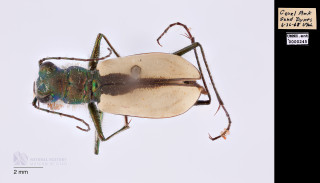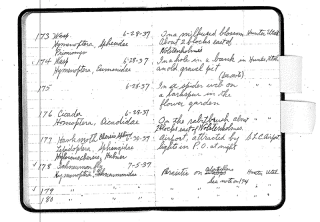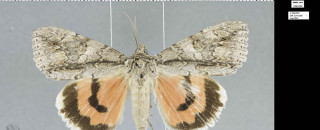Citizen Scientist’s Insect Collection Continues Family Legacy
A moth from the collection donated to NHMU by the family of Ezra Day. © NHMU
By Grant Olsen
April is Citizen Science Month and we’re highlighting some of the impactful ways that members of our communities contribute to the Museum. From helping on paleontological digs to digitalizing our collections, citizen scientists play an essential role in our mission to illuminate the natural world and the place of humans within it.
The insect collection of Ezra Day is a prime example. It’s the story of a family legacy that continues to shine through a donation to the Museum.
Origin of a Collector
Ezra Day was born in Hunter, Utah in 1894. As a child, he was tasked with common farm chores. His favorite was fetching water from a spring because there were lots of insects and small animals to discover under the willow trees and currant bushes.
After completing the eighth grade, Ezra’s commitment to learning led him to enroll at Granite High. It was a 28-mile round-trip bike ride to reach the school and it took Ezra six years to receive his diploma due to financial challenges, work obligations, bad weather, among other issues.
In 1926, Ezra married Reta Evans, whose uncle, John William Sugden, was one of the most prominent insect collectors in Utah. Ezra marveled at his collection and endeavored to create one of his own. He collected and mounted his first specimen, a moth, in 1927.
Ezra and Reta shared a passion for nature. After Ezra graduated from the University of Utah with a B.S. in biology, they became charter members of the Nature Study Society of Utah.
“Taking long hikes, bicycle riding to Great Salt Lake and the swamps, buggy rides to the mountains and canyons, was Ezra’s hobby and way to enjoy nature in all its varied forms and shapes,” his wife would later recall.
Building a Noteworthy Collection

Ezra’s insect collection may have begun modestly with homemade materials, but it soon reached a higher level of sophistication. He explored extensively in Utah and also collected specimens throughout North American, South America, and other parts of the world. Ultimately, he gathered about 5,400 specimens
Ezra loved sharing his collection with others. He gave presentations at local schools, appeared on television programs, and helped countless scouts earn their merit badge in insect study. His door was always open when people wanted to come to view his collection.
Partnering with the Museum
After Ezra passed away in 1980, his family treasured the collection that by now took up a whole room of a house. Over the years, they discussed the possibility of donating Ezra’s insect specimens, field notebooks, and letters to the Natural History Museum of Utah.
“They were initially hesitant about donating the collection to the Museum because they weren’t sure if it would be well cared for,” recalls Christy Bills, the Museum's invertebrate collections manager. “I promised them that we would take good care of the collection and they could come visit it at the Museum and continue having a special connection with it."
Ezra’s family still comes to the Museum and takes pride in the collection. The experience continues to inspires his great-grandchildren to love the natural world and support the Museum's research.

While the thousands of specimens in the collection are stunning, the field notebooks are just as valuable. Ezra was a meticulous collector who recorded great data on when and where everything was found. But the notebooks aren’t just about data, as they include family stories and show how tenderly Ezra viewed his loved ones. The entries are so lyrical in nature that Paisley Rekdal, an English professor at the University of Utah and past Poet Laureate of Utah, has had her students read through them.
A Vibrant Legacy
The Museum is constantly adopting new best practices to improve its collections and make them more accessible to the world. It has added catalog numbers to the specimens in Ezra’s collection and research teams, sometimes assisted by members of the Day family, have been transcribing his field notes. The magnificent collection is now available on global databases, so experts, students, and enthusiasts alike can view the specimens and learn more about them.
Even as Ezra’s collection reaches a broader audience than he ever could have imagined, it maintains a distinctly Utah feel. A large portion of the insects were collected here in the state, including his personal favorite, the tiger beetles that he usually found on the west side of the Salt Lake Valley.
“I love his tiger beetles,” says Bills. “They are very lovely, and they’re adapted to living in harsh environments like the shores of the Great Salt Lake. They can be emerald green, ruby red, and many different colors.”
Ezra’s beetles and other specimens have definitely proved resilient through the passing years. As his great-grandchildren visit the museum and volunteer their time, they’re able to continue to have a personal relationship with the collection through a unique family legacy housed at NHMU.



